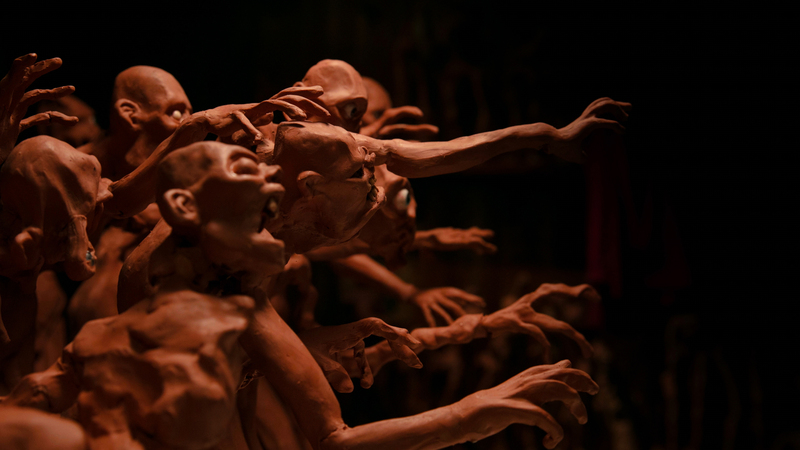
The Silence Between Movements Matters
Playing God
MOVIE REVIEW
Playing God
-
Genre: Animation, Horror, Short
Year Released: 2024, 2025
Runtime: 9m
Director(s): Matteo Burani
Writer(s): Matteo Burani, Gianmarco Valentino
Where to Watch: shown at the 2025 Tribeca Film Festival
RAVING REVIEW: What do you do with the things you can’t fix? That question hovers over every frame of this strangely moving animated short. Born from exhaustion and driven by an obsession with control, it offers a stripped-down but emotionally loaded reflection on perfectionism and the creative urge to build. Despite a brief runtime, it echoes, especially for those who know what it feels like to be left behind, unfinished, or not quite enough.
The story is told without words, and that silence is its strength. A sculptor breathes life into a new figure only to discard it like the others littering his workshop. The space feels less like a studio and more like a confessional booth—cramped, isolated, and filled with judgment. The clay protagonist, still forming its sense of self, stumbles through that loneliness in search of meaning. There’s no grand journey here. No monologue to explain what’s going on. Just movement, reaction, and raw material in search of value.
One of the most compelling choices made here is how the visuals don’t just support the story—they are the story. Producer and animator Arianna Gheller shapes each moment with extreme care, using stop-motion as a tool and an extension of the message. The figure’s slight twitches and hesitations are packed with more expression than many live-action performances. By choosing not to include dialogue, the shorts let body language and gestures do the talking.
Red clay, chosen for its symbolism and ties to the director’s roots, becomes the perfect stand-in for identity—malleable, flawed, constantly reshaped by others’ expectations. This isn't just a story about a discarded creation; it reflects the creator himself. When the sculptor deems his work unworthy, it stings not because of cruelty, but because of how familiar that cycle feels. We make, judge, and throw away—sometimes the thing, sometimes ourselves.
The score doesn’t lead or overstate; it reacts. It breathes alongside the clay and gives weight to moments that might otherwise pass in silence. That balance between restraint and emotion is key to the short’s effectiveness. Every decision, from sound design to the ambient sounds of the workspace, keeps the atmosphere grounded while evoking something internal.
The cinematography by Guglielmo Trautvetter deserves mention for how well it matches the tone. Lighting becomes more than mood—it functions as another storytelling device. Shadows don’t just fall across figures for drama; they serve as cues to the sculpture’s isolation, to the disconnection between the creator and the created. Limiting the visual palette makes every frame feel tightly focused, almost claustrophobic, which enhances the emotional arc.
What gives the story its staying power is its refusal to draw a clear line between artist and subject. Instead, it blurs that boundary. The creator isn’t just playing god—he’s questioning himself through actions. And the clay figure, in its rejection and eventual recognition of shared despair among other castoffs, isn’t simply seeking approval. It’s wrestling with what it means to be made and then forgotten.
When the newest figure finally acknowledges the others, that shared moment flips the story’s emotional switch. It's no longer just about rejection; it becomes about community, about the solace found in others who know the same struggle. That choice, quiet and almost hidden in the chaos, shapes the story. It's not triumphant, not tragic, just honest.
Short-form animation can sometimes feel like a showcase for technical talent, but this piece makes the rare move of aligning technical precision with insight. The animation isn’t just beautiful—it’s purposeful. The themes don’t shout—they unfold. And while it may not give everyone what they expect, it delivers exactly what it promises: a deeply personal expression of the mess we make when we try to measure our worth in perfection.
In the end, the short leaves behind more questions than answers, and that’s its quiet strength. Rather than pretending to resolve the creative crisis, it invites you to sit with it. To watch a sculptor fail—and maybe see yourself in the effort, flaws, and discarded scraps that still mattered.
Please visit https://linktr.ee/overlyhonestr for more reviews.
You can follow me on Letterboxd, Instagram, Twitter, and YouTube. My social media accounts can also be found on most platforms by searching for 'Overly Honest Reviews'.
I’m always happy to hear from my readers; please don't hesitate to say hello or send me any questions about movies.
[photo courtesy of STUDIO CROMA, AUTOUR DE MINUIT PRODUCTIONS, ONIRA]
DISCLAIMER:
At Overly Honest Movie Reviews, we value honesty and transparency. Occasionally, we receive complimentary items for review, including DVDs, Blu-rays, CDs, Vinyl Records, Books, and more. We assure you that these arrangements do not influence our reviews, as we are committed to providing unbiased and sincere evaluations. We aim to help you make informed entertainment choices regardless of our relationship with distributors or producers.
Amazon Affiliate Links:
Additionally, this site contains Amazon affiliate links. If you purchase through these links, we may receive a commission. This affiliate arrangement does not affect our commitment to honest reviews and helps support our site. We appreciate your trust and support in navigating these links.